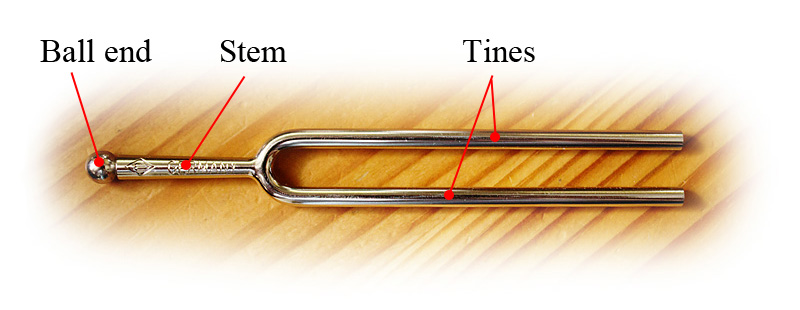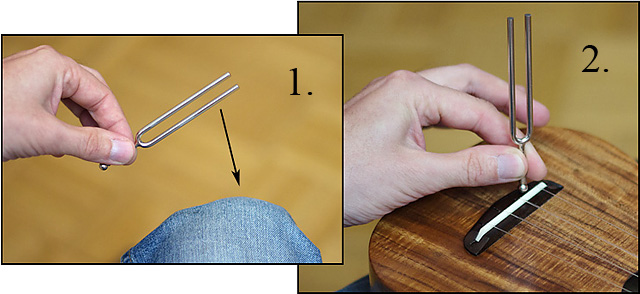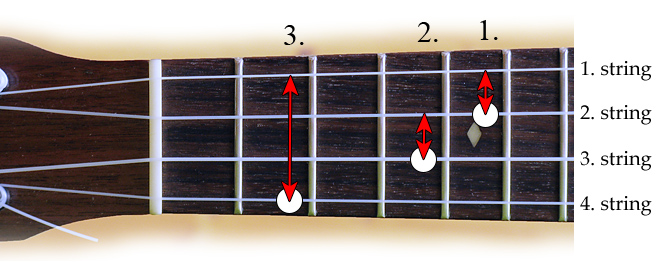Tuning with a Tuning Fork
 The tuning fork
The tuning fork
The tuning fork is a simple means for providing a standard of pitch. Most tuning forks produce the note a’ (=A4) at a frequency of 440 Hz, also known as “concert pitch” (“Kammerton” in German). There are also specialized tuning forks for other notes, but for the ukulele an inexpensive standard A4 tuning fork, as shown by the illustration, is best suited.
In order to produce a tone with the tuning fork, hold it at its stem, and hit a tine against a firm (but not too hard) object — for example your knee. Then gently press the ball end against a resonanting body — this could be a table surface, however holding it against the bridge of the ukulele will work best.
Tuning the note a’ by using the beating
Produce the reference tone as described, and tune the A string. On the ukulele, the A string must be tuned to match the reference tone of the tuning fork exactly. This makes it easier compared to the guitar, where the A string is tuned 2 octaves deeper than the tone of the tuning fork.
I explained on the page Tuning by reference tones how to tune by using the beating. When using the tuning fork correctly, the beating will be very well hearable, which allows for a very accurate tuning.
Tuning the other strings (GCEA tuning with high G)
First tune the A string using the tuning fork. Then all other strings can be tuned using the A string as a reference. In order to tune one of the other strings, fret it so that it should produce the same note like a string which is already in tune. Now tune it until the tones of the two strings match:
- The 2nd string fretted at the 5th fret — should match the open 1st string.
- The 3rd string fretted at the 4th fret — should match the 2nd string.
- The 4th string fretted at the 2nd fret — should match the 1st string.
So, for tuning the E string (2nd string), fret it at the 5th fret and pluck both the E and the A string at the same time. Now you can tune the E string using the beating.
Then tune the C and the G string accordingly.
It’s important to fret with a very light touch! Don’t press the strings so hard that they touch the fretboard, otherwise you’ll bend the tone and won’t achieve a precise tuning!
Right after tuning, play a few chords and check if they sound right. There should be none or only very slight (slow) beating hearable when playing chords on a well tuned ukulele.
For the advanced: Compensatory tuning
Maybe you’ll notice that even after tuning very carefully, you’ll still hear quite some beating in some chords. The main reason for this is that even good instruments almost never have perfect intonation. This can be improved significantly by optimizing the setup of the ukulele. However, absolute perfection cannot be achieved.
When using an electronic tuner for tuning, all this is often not apparent, since the electronic tuner doesn’t teach you to pay attention for the beating and the purity of intervals. This is a severe disadvantage in my humble opinion.
It is possible to compensate the imperfection of an instrument to some extent by slightly adapting the tuning. Don’t expect miracles: An ukulele with severe intonation problems will always sound awful. However, very slight variations from perfection are tolerable for the ear. If the beating gets very slow, it’s no longer annoying.
So, play the most important chords for the piece you want to play, and watch out for the beating, and how it changes when carefully re-tuning single strings. Very often, it’s possible this way to find a tuning in which all chords you want to play sound right.
Just don’t spread yourself too thin in the search for perfect purity of sound. A little bit of “sonic movement” is normal and cannot be eliminated entirely, not even with a perfect instrument. And mind that it can even serve the music if some chords sound purer than others.
Practical example for compensatory GCEA tuning
A compensatory tuning which works very well for most ukuleles can be achieved like this:
- First, tune the A string using a tuning fork.
- Now tune the E and the C string by using the A string as reference.
- Now fret the A string at the 3rd fret and pluck it together with the empty (=not fretted) C string. If you can’t hear any beating, this speaks in favour of the quality of your ukulele. Otherwise, try to compensate the deviation by “distributing” the beating: Modify the tuning of the E and the C string so that all three combinations sound acceptable:
- The empty A string together with the E string fretted at the 5th fret.
- The empty E string together with the C string at the 4th fret.
- The empty C string together with the A string at the 3rd fret.
- Now, we can tune the G string. We tune it so that the following two combinations sound acceptable:
- Empty A string together with G string at the 2nd fret.
- Empty G string together with E string at the 3rd fret.
In case you can’t achieve a good tuning this way, it might be a good idea to improve the setup of the ukulele in order to achieve proper intonation.
Compensatory playing technique
In my experience, on many ukuleles, fretted notes sound a little bit too high. This is unfavorable, however it can be rectified with a suitable setup: If the instrument is setup in a way that fretted notes tend to sound a little bit too low instead, the “right” intonation can be achieved by slightly varying the pressure when fretting the strings. Some very skilled players seem to be doing this intuitively, thus achieving a high purity of tone.



 English
English  Deutsch
Deutsch